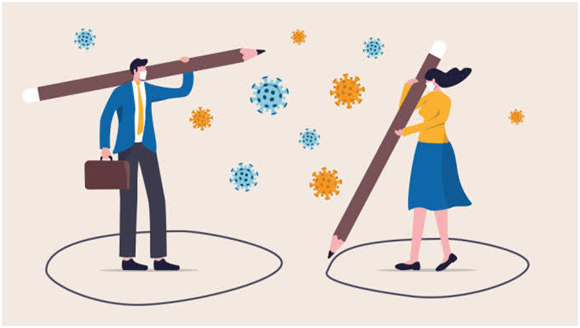Psychological impact of pandemic on an artist
Written By: Akanksha Brahme (Counselling Psychologist and Bharatanatyam NrutyaVisharad)
(2nd winner of NrutyaShabda Dance Essay Writing Competition, 2020 Junior Group, Organized by Samvaad Performing Arts Blog - Swarada Dhekane & Loud Applause Dance E-Magazine - Neha Muthiyan)
Subtopic : Mental health of Indian classical dancers during the period of pandemic
As we all are human beings and survive to meet our needs, we find the way or another to fulfil those needs to get satisfaction. Indian classical dancers also created some new ways to deal with this stressful situation during pandemic.During this period of pandemic, Indian classical dancers faced many changes. The daily practice under the guidance of their Gurus was replaced by online classes and the instructions such as "Stay in the Ayatam properly" were replaced by a constant question - " Am I audible? ". Not only the daily practice but also the exams were conducted online. The pandemic has opened up new opportunities in this virtual world such as experimenting new choreographies and uploading the videos on social media platforms. Though this cannot match up the feel of performing in front of an audience at live dance festivals, we all have started finding satisfaction in more views and likes for our video. Many workshops were also conducted online by the experts which were beneficial for the students.
As mentioned earlier, Indian classical dancers faced different changes which affected their mental health. The term we all use every time was actually experienced literally during every single day of pandemic and that was "Stress". In an artist's life, the daily practice routine plays an important role. It is not only important for their physical wellness but also for mental wellness. The sudden change in their routine resulted in the stress. When we experience stress, it brings conflict and anger along with it. The Indian classical dancers also faced this due to several financial, professional and ethical reasons.
Especially during the period of lockdown, the uncertainty and unpredictability about this Covid-19 situation lead to overthinking. Being the natural tendency of human beings, we hardly think in a positive way. The negative thoughts lead to unhelpful thinking styles such as , "Nothing good ever happens" , "This happens only with me", "What if this will not change?",etc. These unhelpful thinking styles affect self-confidence and self-esteem. This hampers mental and psychological wellbeing of performing artists such as Indian classical dancers. This may also create anxiety amongst them and this vicious circle of negative thinking continues until we don't restructure them into positive ones.
Though everyone has their different coping strategies, dance itself has a therapeutic value to deal with stress. The Psychologist Martin Seligman has given a model named PERMA which states five core elements of wellbeing. Each component contributes to our wellbeing and happiness. The following image has beautifully explained five elements of the PERMA Model.
Dance is an artform which enables a dancer to experience all above elements. For a dancer, the activity which makes them feel good is dancing which ultimately leads to the first element i.e Positive Emotions. While performing or practicing, the dancers generally lose track of time which is the second element of the model called Engagement. This pandemic period made us realize the importance of relationships. Not only the personals but also professional relationships. The virtual performances and classes brought joy, peace and support in life which reminded us of the sense of belongingness. It is nothing but the third element i.e. Relationships. In Indian classical dance, we always say that dance is a spiritual experience which ultimately leads to the fourth element of the model called Meaning. It takes years of practice to achieve excellence in Indian classical dance. Every next step in the choreography is a goal and attaining it gives us a sense of accomplishment.
We have to accept the fact that many artists gave up during this pandemic situation. Indian artists were also no exception to this. But on The other hand, many Indian classical dancers found new ways to flourish and find happiness during this period of pandemic. The online classes, virtual performances, reaching out to a wide range of people through workshops and lecture series increased their self-confidence, self-esteem, self-worth and creativity. We have always read a quote saying, " Dancers don't need wings to fly". This pandemic has proven it once again. It is the power of that artform itself. Hence it is said that - "Paramatma is depicted as a dancer because only in the art of dance, the creator and creation is the same. The dance happens in the dancer's own body. The creator Paramatma and his creation are not separate."
_______________________________________________________________________________
● References :
https://www.news18.com/news/buzz/the-changing-landscape-of-indian-classical-dance-forms-and-struggles-performers-are-facing-amid-pandemic-3106025.html
● Images references : Internet
https://www.news18.com/news/buzz/the-changing-landscape-of-indian-classical-dance-forms-and-struggles-performers-are-facing-amid-pandemic-3106025.html
● Images references : Internet
________________________________________________________________________________





Comments
Post a Comment